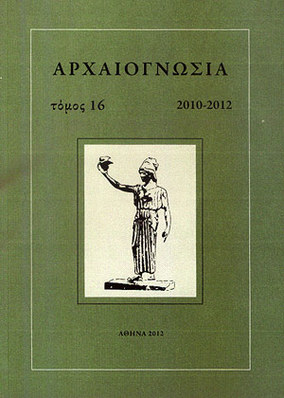Δεξαμενή-αποθέτης στην περιοχή του Θησείου
Part of : Αρχαιογνωσία ; Vol.14, No.1, 2006, pages 59-94
Issue:
Pages:
59-94
Parallel Title:
A bottle-shaped cistern in the region of Theseion
Section Title:
Μελέτες = Articles
Abstract:
The 3rd EPCA (Ephorate of Prehistoric and Classical Antiquities) carried out a rescue excavation in the region ofTheseion, Athens, from 28/6 until 4/9/1985 under the supervision of the archaeologist E. Lygouri - Tolia in a block surrounded by Aktaiou, Efestion and Eptahalkou streets, where a public school building was to be built. Two burials of the middle Geometric period, a well and a cistern of the Hellenistic period and a ceramic kiln of the Roman period were found. The archaeological remains were buried after the excavation and remain undisturbed beneath the school building. A permit for the study of the structure of the cistern as well as of the material it yielded (late Hellenistic pottery) was granted to the authors, as part of their postgraduate research that resulted in two Master’s respectively. The type of the cistern and two important categories of pottery, namely the stamped amphora handles and the lamps, were examined in detail. The latter, in particular, were selected as they were thought to provide a date for the deposit that sealed the cistern.The cistern, cut into the local clayey schist bedrock, was a large subterranean bottle-shaped chamber used for the collection of rainwater. A circular depression at the bottom served as a settling basin. A tunnel - like passage, triangular in section, was cut into one side of the cistern, yet it was not fully excavated. Therefore, it could either be blind, constructed to increase the capacity of the cistern or might be leading to a yet undiscovered second cistern nearby, forming in this way a system of cisterns. A significant feature of the Theseion cistern is the presence of a stepped descent to the chamber, which occurs extremely rarely in Hellenistic bottle-shaped cisterns.The detailed study of seventy seven stamped amphora handles and forty nine complete and fragmentary lamps from the cistern shows that during the second half of the 2nd until the turn to the 1st century BC the cistern served as an apothetes for discarded material from nearby installations. The material consisting of coarse and fine ware, was probably domestic refuse, since no kiln failures were found in the deposit, although the cistern lies in an area of Athens, where metal and ceramic workshops were thriving in Hellenistic times.
Subject:
Subject (LC):
Keywords:
γεωμετρική περίοδος
Notes:
Περιέχει εικόνες, παράρτημα πινάκων (με τίτλο "Συνοπτικοί κατάλογοι ενσφράγιστων λαβών αμφορέων") και κατόψεις




